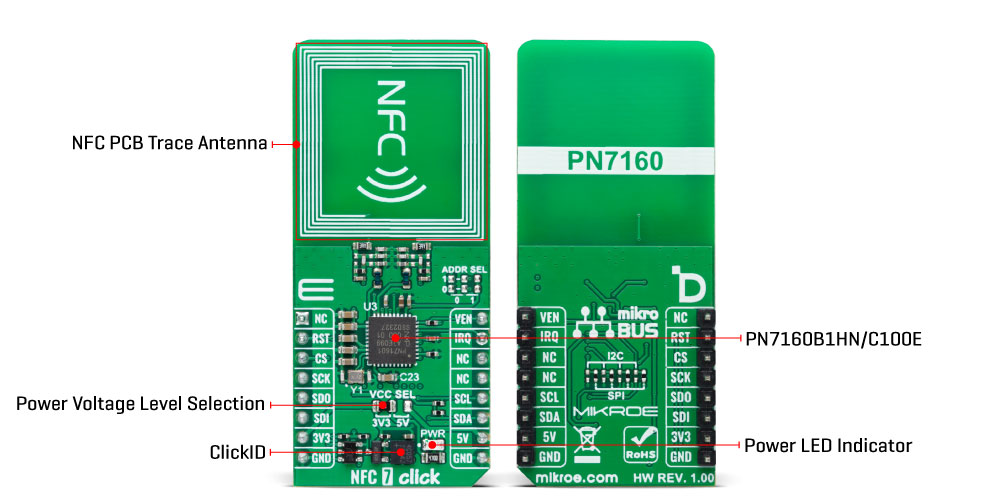OFF
GO LOCAL
| Company | Stock | Price |
|---|---|---|

MIKROE-6452
18 g
Status:
NFC 7 Click - SPI is an add-on board that integrates NFC functionality in various applications. This board features the PN7160 (PN7160B1HN/C100E), a Near Field Communication (NFC) controller from NXP that is compliant with NFC Forum and NCI 2.0 standards. The board features an SPI communication interface, low-power consumption modes, and a new-generation RF contactless front-end design with high sensitivity and dynamic load modulation for reliable communication. It supports multiple NFC standards, including ISO/IEC 14443, ISO/IEC 15693, MIFARE, and FeliCa, and offers standalone card emulation functionality. Ideal for mobile devices, wearables, personal digital assistants, consumer electronics, and smart home gateways, NFC 7 Click ensures efficient and versatile NFC performance for modern applications.
NFC 7 Click is fully compatible with the mikroBUS™ socket and can be used on any host system supporting the mikroBUS™ standard. It comes with the mikroSDK open-source libraries, offering unparalleled flexibility for evaluation and customization. What sets this Click board™ apart is the groundbreaking ClickID feature, enabling your host system to seamlessly and automatically detect and identify this add-on board.
NOTE: This product is also available in an I2C interface version. For more information, please visit the NFC 7 Click - I2C product page.
This product is no longer in stock
Availability date:
OFF
| Company | Stock | Price |
|---|---|---|

NFC 7 Click is based on the PN7160, a Near Field Communication (NFC) controller from NXP. This versatile NFC solution is designed to comply with NFC Forum and NCI 2.0 standards, offering robust integration for a wide range of NFC-enabled applications. This version of NFC 7 Click communicates with the host MCU exclusively through an SPI interface (PN7160B1HN/C100E) and provides an optimized architecture for low-power consumption. The PN7160 features multiple power-saving modes, including a Hard Power-Down state, a firmware-activated Standby state, and a low-power polling loop for automatic device discovery to ensure efficient energy use across various operating scenarios. NFC 7 Click is particularly well-suited for portable and low-power applications where reliable NFC functionality is essential, including mobile devices, wearable technology, personal digital assistants, consumer electronics, and smart home gateways.

At its core, the PN7160 incorporates a new generation RF contactless front-end, supporting transmission modes compliant with NFCIP-1 and NFCIP-2, as well as ISO/IEC 14443, ISO/IEC 15693, MIFARE, and FeliCa standards. This advanced design significantly enhances performance by delivering higher sensitivity and active load modulation capabilities. These improvements allow NFC 7 Click to maintain reliable communication even with small antenna designs, such as the one integrated into this board.
The PN7160 introduces Enhanced Dynamic Load Modulation Amplitude (DLMA), which adapts the modulation amplitude dynamically based on external field strength. This feature extends communication distances in card emulation mode, ensuring independent phase adjustments for Type A, B, and F communication with 5° precision. Additionally, dynamic power control enables the board to operate at maximum power in reader mode without surpassing standard-defined limits, even at zero distance. In standalone card functionality, the PN7160 can operate autonomously once configured by the host MCU, allowing Passive Integrated Circuit Card (PICC) features to function without requiring the host to remain powered on. This makes NFC 7 Click an ideal solution for energy-efficient and always-on NFC applications.
As mentioned, NFC 7 Click uses a standard SPI communication protocol, allowing the host MCU to control the PN7160 with clock frequencies up to 7MHz. At the back of the board features a set of resistors that need to be populated depending on the board version; in this case, only the resistors in the SPI positions are populated, as required for SPI functionality. Besides the interface pins, NFC 7 Click incorporates the VEN pin, which places the device into Hard Power-Down mode to conserve energy when not in use. It also uses the IRQ pin to handle interrupt requests, providing a mechanism for the host MCU to respond promptly to events such as tag detection, completed operations, or errors, enhancing the overall responsiveness and efficiency of NFC-based applications.
This Click board™ can operate with either 3.3V or 5V logic voltage levels selected via the VCC SEL jumper. This way, both 3.3V and 5V capable MCUs can use the communication lines properly. Also, this Click board™ comes equipped with a library containing easy-to-use functions and an example code that can be used as a reference for further development.
Type
RFID/NFC
Applications
Ideal for mobile devices, wearables, personal digital assistants, consumer electronics, and smart home gateways
On-board modules
PN7160B1HN/C100E - Near Field Communication (NFC) controller from NXP
Key Features
Compliant with NFC Forum and NCI 2.0 standards, SPI protocol with clock frequencies up to 7MHz, Hard Power-Down, firmware-activated Standby, and low-power polling loop for device discovery, high sensitivity and active load modulation, NFCIP-1, NFCIP-2, ISO/IEC 14443, ISO/IEC 15693, MIFARE, and FeliCa standards, and more
Interface
SPI
Feature
ClickID
Compatibility
mikroBUS™
Click board size
L (57.15 x 25.4 mm)
Input Voltage
3.3V or 5V
This table shows how the pinout on NFC 7 Click corresponds to the pinout on the mikroBUS™ socket (the latter shown in the two middle columns).
| Label | Name | Default | Description |
|---|---|---|---|
| LD1 | PWR | - | Power LED Indicator |
| JP1 | VCC SEL | Left | Power Voltage Level Selection 3V3/5V: Left position 3V3, Right position 5V |
| Description | Min | Typ | Max | Unit |
|---|---|---|---|---|
| Supply Voltage | 3.3 | - | 5 | V |
| Subcarrier Frequency | - | 13.56 | - | MHz |
NFC 7 SPI Click demo application is developed using the NECTO Studio, ensuring compatibility with mikroSDK's open-source libraries and tools. Designed for plug-and-play implementation and testing, the demo is fully compatible with all development, starter, and mikromedia boards featuring a mikroBUS™ socket.
Example Description
This example demonstrates the use of NFC 7 SPI Click board by handling the detection and processing of various NFC technologies and protocols, and ensuring the application can respond to different NFC card types (A,B,F,V).
Key Functions
nfc7spi_cfg_setup Config Object Initialization function.nfc7spi_init Initialization function.nfc7spi_default_cfg Click Default Configuration function.nfc7spi_wait_discovery This function waits until remote NFC device is discovered.nfc7spi_presence_check This function waits until the discovered target device is removed.nfc7spi_stop_discovery This function stops the RF discovery process.Application Init
Initializes the driver and logger, performs the Click default configuration and reads the device firmware version.
Application Task
Waits for an NFC device to be discovered, checks if it supports a known NFC technology, and then handles the device based on its protocol. The application continues processing the device (reading and writing information) and waits until the card is removed. Once the card is removed, the discovery process is restarted to detect a new NFC device.
Application Output
This Click board can be interfaced and monitored in two ways:
Additional Notes and Information
The complete application code and a ready-to-use project are available through the NECTO Studio Package Manager for direct installation in the NECTO Studio. The application code can also be found on the MIKROE GitHub account.
NOTE: Please be advised that any peripheral devices or accessories shown connected to the Click board™ are not included in the package. Check their availability in our shop or in the YMAN section below.